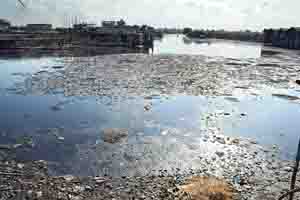News >> Metro
 28 Aug, 2013
28 Aug, 2013
Untreated effluents from Hazaribagh tanneries and dumping of garbage on a regular basis have effectively blocked the Rayerbazar Canal flowing into Buriganga River near Shikdar Medical Hospital. Side by side with tannery wastes and effluents, continuous throwing of polythene and kitchen wastes have helped the garbage consolidate into a land-like surface luring land grabbers to extend their footholds on the edge of the canal causing it to gradually disappear. Now it has become a breeding ground for the mosquitoes, creating a serious health hazard for the densely populated neighbourhood of the city’s low-income groups with a round-the-clock strong stench of the rotting broth of tannery and household wastes.
Meanwhile, toxic poultry and fish feeds are being prepared from the raw wastes of the Hazaribagh tanneries, and heavy metals, such as lead, are being passed on to the consumers, through carcinogenic meat, eggs and fish. These are posing serious health hazards to consumers, warn experts.
All this is in blatant violation of a 2010 High Court order. But, the department of livestock services (DLS) and the department of environment (DoE) are busy passing the buck between each other, and are not taking steps to stop such dangerous poultry and fish feed production. Tannery wastes are burnt to ashes and then turned into balls of poultry and fish feeds, which farmers prefer as cheap alternatives to imported feeds.
A section of unscrupulous people is involved in producing these harmful poultry and fish feeds.
At least 80 factories have been set up on both sides of the embankment or bund on the western bank of the Buriganga. Their business has been flourishing despite a High Court order of July 26, 2010, directing that these be closed. Neither the police, the DLS nor the DOE have bothered to implement the court order, so far.
The DOE has, from time to time, announced its intention of carrying out drives to shut down these factories, so as to choke off the sources of production. The practice of burning highly toxic tannery wastes at Hazaribagh, Rayerbazar, Kamrangirchar and parts of west Dhanmondi are also posing a serious health hazard to residents of these densely populated areas, as they have to inhale the polluted air.
According to a test report of the Bangladesh Council of Scientific and Industrial Research (BCSIR), poultry and fish feeds that are produced by burning lead and chromium-rich tannery wastes are a great threat to human health. The tests were carried out in 2009 on eggs collected at random from the Dhaka city markets, and confirmed the presence of lead in the poultry products. Other heavy metals were also found in poultry and fish feeds manufactured using solid wastes from tanneries.
The then chairman of BCSIR, Prof. SM Imamul Huq, said at least 120 types of chemicals, such as sulphuric acids, caustic materials, ammonia, chromium, salts, formaldehyde, glutaraldehyde, hydrogen peroxide, organic solvents, aluminium sulphate, carbon black, enzymes, dye stuffs laced with leads and fungicides are used in the tanning process.
In the long run, chromium, lead, cadmium, mercury, arsenic and nickel may damage the kidney, bones, brain, blood, liver, lungs and central nervous and cardiovascular systems, if people consume poultry and fish grown on feed laced with such chemicals, he added.
Paribesh Bachao Andolon chairman Abu Naser Khan said the tanneries of Hazaribagh dump 21,000 cubic metres of untreated waste into the river every day. The tanneries are dumping extremely lethal waste, laced with chromium and other heavy metals used in tanning hides and skins, added the green activist, who has been campaigning for clean food for a long time.
Talking to The Independent, DLS director general (DG), Dr Mosaddique Hossain, and the DoE’s DG, Golam Rabbani, passed on the responsibility for stopping the harmful production of poultry and fish feeds to each other.
Dr Mosaddique Hossain said, “It is the responsibility of the DoE to stop such practices.”
“We will bring them under the law. We plan to conduct a drive next week to stop production of such harmful substances,” the DG of the DoE said.
Golam Rabbani said this should be stopped at any cost. “We are not responsible for stopping such production, because it is the jurisdiction of the DLS. We are looking after environment-related pollution.”
The DG of the DoE said, “We are eating toxic food through the poultry. The DLS could use us during their drives against the unscrupulous producers.” The DoE has conducted a drive against poultry and fish-feed producers, recently, he added.
Tanning industries of Hazaribagh process around 220 tonnes of hides a day and, in turn, produce 600 kg to 1,000 kg of skin-cut wastes (SCW) from each tonne of processed hide.
Source: Independent

